ABSTRACT
A two year study was carried out in two locations in south eastern Nigeria in the years 2008 and 2009, to determine the effect of planting space on plant population at harvest, and corm yield in cocoyam cultivars. This was aimed to identify optimum planting space for optimum cocoyam production. Five taro cultivars; Nkpong, Ugwuta, Nworoko, Odogolo and Nadu were used. Three planting space; 50 x 100 cm, 40 x 100 cm and 30 x 100 cm were tested. The result showed that decreasing planting space from 50 x 100 cm to 40 x 100 cm resulted to increase in plant population at harvest. There was a decline in plant population as planting space was further decreased to 30 x 100 cm. The closest planting space of 30 x 100 cm produced the highest tuber yield ha-1 among the three planting space in the two locations. The result also showed that the Ugwuta cultivar produced the highest tuber yield among the five cultivars in the Nsukka location while the Odogolo cultivar recorded highest tuber yield in the Umudike location. It was therefore recommended that planting at the spacing of 30 x 100 cm should be adopted as a production practice in these areas for high tuber yield in cocoyam.
Key words: Cocoyam, cultivars, planting space, population, tuber yield.
Cocoyam is the common name for two tuber crops Colocasia esculenta and Xanthosomona sagitifolum. Cocoyam is an important crop grown for its starchy corms and is a staple food throughout the rural subtropical and tropical regions of the world especially in the Pacific and Caribbean islands and West Africa (Hancock, 2004). Together with yam and cassava, cocoyam forms the major source of carbohydrates in Nigeria. Cocoyam cultivation in Nigeria is concentrated in southwestern and southeastern parts of the country due to favourable ecological conditions in these areas (Shiyam et al., 2007). Cocoyam production, like production of other crops, is still carried out by poor rural farmers with low production technologies. These resource poor farmers account for over 90% of Nigeria’s agricultural output through the use of the indigenous farming practices.
Nigeria is presently the world highest producer of cocoyam producing about 1800000 tons per annum, accounting for about 30% of world total and 48% of Africa total production (Onwueme and Sinha, 1991; Eze and Okorji, 2003). Yield is still low in Nigeria as a result of poor production practices. There is therefore the need to enhance the production of cocoyam as this will help to reduce food shortage and also help in alleviating poverty among rural people.
Plant response to spacing varies from species to species and is highly dependent on such environmental conditions as soil characteristics, biotic elements and climatic conditions of the site. Planting with space according to Hailu and Sue (2011) involves the growing of plants on a plot of land with sufficient space between each of the plants so that they can develop their roots and shoots more fully. Cocoyam is a rhizomatous plant and when planted produces a number of suckers which develop into full plants/plantlets. Hence the expected plant population at planting will always be less than the plant population at maturity due to the emergence of these plantlets. Squire (1990) reported that production increases as population increases until a point is reached when further increase only lead to slight increase in production. He attributed the high production to high leaf area index. To maximize production therefore interception of light by chloroplast must be maximized to enhance photosynthesis upon which yield of crops is totally and directly dependent (Barden et al., 1989). Such increases in yield with decrease in plant spacing have been reported in other crops (Ogbonna and Obi, 2000; Ofori and Stern, 1987; Pardales and Belmontes, 1984; Bolton, 1971). Osundare, (2006) however, noted that average cormel weight decreases with increase in plant population. The objectives of this study are to determine the effect planting space on plant population at harvest and tuber yield in cultivars of cocoyam. This was aimed at identify high yielding and stable cocoyam cultivar and optimum planting space for maximum cocoyam production.
To address the objectives of the study, field practical experiments were conducted in two locations in southeastern Nigeria namely; University of Nigeria, Nsukka in Enugu state (latitude 06°52’N longitude 07°24’E and at altitude 442 m above sea level), National Root Crop Research Institute (NRCRI), Umudike in Abia State (latitude 05°29’N, longitude 07 33’E and at altitude 122 m above sea level. The experiments were carried out in the growing season of two years, Nsukka location (2008) and Umudike (2009).
Material
Three local cultivars of cocoyam (Colocasia esculenta); Odogolo, Nworoko and Nadu were sourced from the study area. Two cocoyam varieties; Ugwuta and Nkpong were also obtained from NRCRI Umudike, bringing the number of cultivars to five. The experiment was a factorial experiment in Randomized Complete Block Design (RCBD). The treatments consist of five cocoyam cultivars and three planting space of 50 x 100 cm, 40 x 100 cm and 30 x 100 cm, respectively. This resulted to 15 treatments combinations and was replicated into four.
The land was ploughed, harrowed and ridged before marking out into blocks and plots according to the experimental design. Planting was done immediately after land preparation at the depth of 10 cm.
Two weeding were carried out manually with hoe before maturity. NPK 15:15:15 fertilizer was applied at the rate of 200 kgha-1 at eight weeks after planting. At maturity, expert women harvesters were engaged to harvest the cocoyam.
Data collection and analysis
Records were taken on number of plants per plot, number of cormels per stand, weight of cormels per stand, average cormel weight, weight of corm per stand, total tuber yield per stand, cormel yield ha-1 and total tuber yield ha-1. These data were subjected to analysis of variance (ANOVA). This was carried out using the method outlined by Steel and Torrie (1980) for factorial experiments. Separation of means for statistical significance was by the F-LSD procedure described by Obi (2001). The F-LSD was calculated at 5% significant level. Meteorological records were obtained from meteorological stations at both institutions.
Soil data
At the time of planting soil samples were taken at different representative locations in each experimental site at the depth of 0 to 20 cm. The samples were thoroughly mixed to obtain a composite sample for each location from which a sub sample was used for laboratory analysis to determine the physical and chemical properties of the soil.
The result of soil analysis for the two locations is shown in Table 1.The result indicated that the soils of Nsukka and Umudike were texturally clay soil and loam soil, respectively. Their acidity levels were not too far apart however, Umudike appeared to be more fertile having higher quantities of organic matter and minerals than Nsukka soil. The weather data from the two location presented in Table 2 also revealed that rainfall started earlier in the year in Umudike. Also, high amount of rainfall and better distributed was recorded in Umudike. Temperature and relative humidity were also higher at Umudike.
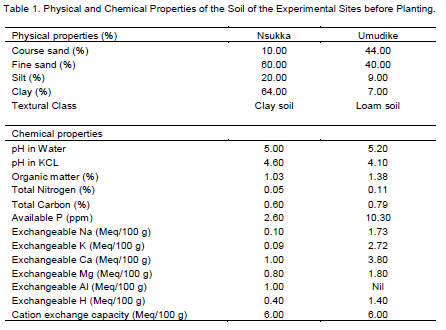

The result of the effect of planting space on plant population at harvest shown in Figure 1 indicated significant effect (P=0.05). Decrease in planting space from 50 x 100 cm to 40 x 100 cm caused a significant increase in plant population at harvest. Further decrease in planting space to 30 x 100 cm resulted to a decline in plant population at harvest. The decline was however non significant. This trend was the same in both locations. Similarly, at Nsukka location, yield components such as number of cormels per stand, weight of cormels per stand, weight of corm per stand, average cormel weight and total tuber yield per stand also decreased significantly in capacity with decreased planting space (Table 3). On the contrary cormel yieldha-1 and total tuber yield ha-1 increased with decrease in planting space, hence planting at 30 x 100 cm planting space produced the highest cormel yieldha-1 and tuber yieldha-1 and were significantly higher than values obtained at 50 x 100 cm planting space but statistically the same with planting at 40 x 100 cm planting space. A similar trend was observed at Umudike location (Table 4).
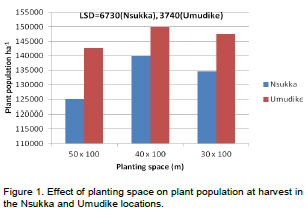


Significant cultivar differences were also identified among the cultivars in plant population at harvest (Figure 2). Nworoko had the highest plant population among the cultivars in the Nsukka location while Nadu was at the top in the Umudike location. However both cultivars did not differed significantly in this attribute at both locations. The lowest plant population at harvest was recorded from Nkpong at both locations. The result presented in Table 5 indicated significant differences among the cultivars grown in the Nsukka location in all the yield components. Odogolo produced the highest number of cormels per stand while Nadu produced the lowest. Ugwuta had the highest weight of cormels per stand and was followed by Odogolo while Nkpong registered the least value. Records on weight of corms per stand showed that Nworoko topped the list followed by Odogolo while Nadu was the last. The highest average cormel weight was recorded in Nadu while Nkpong had the lowest value of average cormel weight. The highest total tuber yield per stand, cormel yieldha-1 and total tuber yieldha-1 were recorded in Ugwuta and was followed by Odogolo. Nkpong ranked the least in all the yield components except in weight of corm per stand. It was noted that Ugwuta, Odogolo and Nworoko produced statistically the same effect in all the yield components measured.
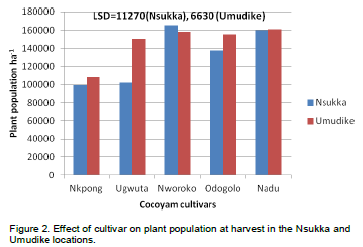

In the Umudike location, significant effects of cultivars were observed in all the yield components. Odogolo recorded the highest performance in all the yield components measured with the exception of average cormel weight in which Nworoko was the best. Ugwuta however ranked second in all the components with the exception of number of cormels per stand. Nkpong was lowest in weight of corms per stand, average cormel weight and corm yieldha-1, while Nadu was lowest in number of cormels per stand, weight of cormels per stand, total tuber yield per stand and total tuber yieldha-1. It was also observed that Odogolo, Ugwuta and Nworoko registered statistically the same effect in all the yield components with the exception of cormel yieldha-1 and total tuber yieldha-1 where they differed significantly (Table 6).
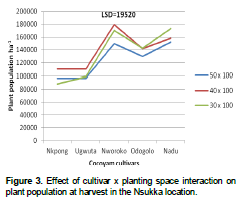
The cultivar x planting space interaction effect was significant on plant population at harvest. The result shown in Figure 3 revealed a trend of increase in plant population at harvest in all the cultivars as planting space decreased from 50 x 100 m to 40 x 100 m and declined as planting space was further decreased to 30 x 100 m in the Nsukka location. The same trend was observed in the Umudike location (Figure 4). The highest plant population at harvest was recorded in Nworoko in Nsukka location while at the Umudike location both Nworoko and Nadu produced the highest number.

Cultivar x planting space interaction effect was also significant in all the yield components measured (Table 7). There was a trend of decrease in number of cormels per stand as planting space was decreased in all the cultivars. Odogolo planted at 50 x 100 m spacing produced the highest number of cormels per stand, weight of cormel per stand, weight of corm/stand, average cormel weight and total tuber yield per stand among the cultivar x planting space combinations. On the contrary cormel yieldha-1 and total tuber yield/ha increased as planting space was decreased in all the cultivars. Highest cormel yieldha-1 and total tuber yieldha-1 were recorded in Ugwuta planted at 30 x 100 m spacing. In the Umudike location the trend of the effect of cultivar x planting space interaction was the same with that of Nsukka location (Table 8). However in this location, Odogolo planted at 50 x 100 m spacing produced the highest values in number of cormels per stand, weight of cormels per stand, weight of corms per stand, average cormel weight and total tuber yield per stand among the combinations. It also recorded the highest cormel yieldha-1 and total tuber yield/ha at the closest planting space of 30 x 100 m.
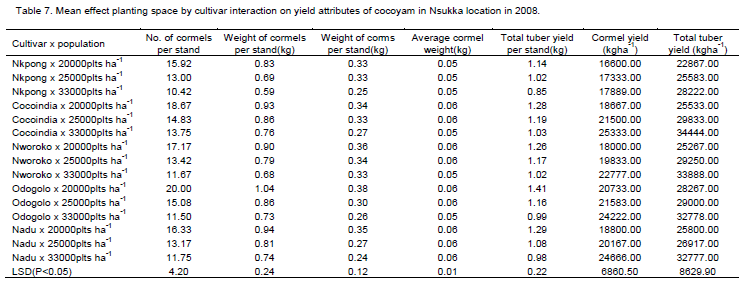
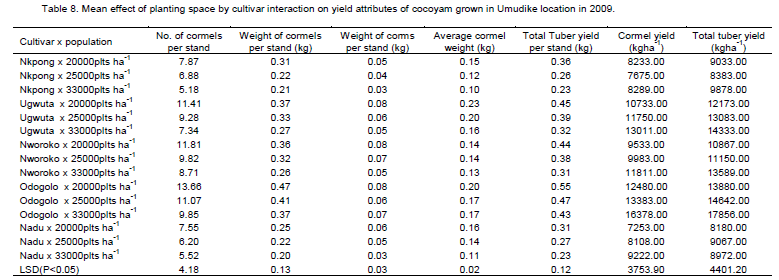

DISCUSSION AND CONCLUSSION
The study has shown that planting space affects plant population at harvest in cocoyam. Plant population at harvest increased with decrease in planting space and peaked at a particular planting space after which further decrease in planting space caused a decline in plant population at harvest. It was also observed that the cocoyam cultivars differed in plant population at harvest irrespective of the planting space. It will be important to note that it may be wrong to make estimate of plant population for some plant species that produce suckers, based on plant spacing at planting as that may entail stating plant populations that are far below the actual plant populations obtained in the field.
The observed decrease in corm and cormel yield per stand at closer planting space was in agreement with the findings of Tumuhimbise et al. (2009), Pardales and Belmonte (1984), Igbokwe and Ogbonnaya (1981) and De la Pena (1977). It has however, been reported that corm yield is a positive function of the number of corms and weight of corms per planting hill (Khan et al., 2003; Kader and Rolle, 2004). Calculated on hectare basis these yield components were found to increase as planting space decreased. In this study highest corm and cormel yieldha-1 were realized from the closest planting space of 30 x 100 cm. This has also been reported by Pardales et al. (1982), Villanueva et al (1983) and Talwana et al. (2010). In south eastern Nigeria, like in many other parts of West Africa, sole cropping is a rare practice, so cocoyam is not normally planted sole but in mixture with other crops. In such combination individual plant population is always low and low yields are recorded (Onwueme and Sinha, 1991; Shiyam et al., 2010). This work has shown that growing cocoyam at closer planting space of 30 x 100 cm produced the highest corm and cormel yieldsha-1 compared to yields recorded at wider planting spaces of 50 x 100 cm and 40 x 100 cm.
The variation in yield among the cultivars collaborate with the findings of Khan et al. (2003). The Cocoindia and Odogolo cultivars were observed to produce highest yield at both locations and at the three planting space, among the cultivars. This is an indication that these cultivars possessed inherent genetic qualities that enhanced growth and development than the other cultivars. Such attributes brings about more efficient use of production factors. Breeding genotypes that are adapted to wide geographical areas and that show some degree of stability from year to year is one of the major challenges facing plant breeders. Such stable genotypes will be capable of utilizing the resources available in higher yielding environments and maintain a mean performance that is above average in all environments (Moll and Stuber, 1974). The Nsukka location appeared to have provided conditions most suitable for cocoyam growth and development; hence all the cultivars performed best at that location. It has been reported by other researchers that yield of root crops are affected by changes in environmental conditions between sites and planting dates (Lu et al., 2001; Scheffer et al., 2005; Kumar et al., 2007; Mare and Mode, 2009).
Planting at the closest spacing of 30 x 100 cm which produced the highest tuber yield in all cultivars will be recommended to farmers. It will also be suggested that further studies will be conducted to determine the effect of planting at spacing that are closer than the ones tested in the present study. This will help to determine the optimum planting space. The Ugwuta and Odogolo cultivars which produced high tuber yield ha-1 will also be recommended to farmers in these areas. It will however be noted that other parameters may also be considered in making a choice. However, the funding for this research could not cover such other areas.
The authors have not declared any conflict of interest.
Author acknowledge the financial and material aids from the CODESRIA – IFS Sustainable Agriculture Initiative, Grant No.T/4434-1 under which this study was carried out and also the support granted by National Root Crop Research Institute (NRCRI), Umudike, Nigeria for granting me the use of their experimental facilities and technical assistance.
REFERENCES
|
Barden JA, Halfacre RG, Parish DJ (1989). Plant Science. McGraw-Hill. NY. P. 551. |
|
|
Bolton A (1971). Response of maize vars in Tanzania to different plant populations and fertilizer levels. Expl. Agric. 7:193-203.
Crossref |
|
|
De la Pena RS (1977). Yield of upland taro at varying plant density. Field Crop Res. 1:183-190.
Crossref |
|
|
|
Eze CC, Okorji EC (2003). Cocoyam production by women farmers under improved and local technologies in Imo state, Nigeria. Afric. J. Sci. 5(1):113-116. |
|
|
|
Hailu A, Sue E (2011). Planting with space. Institute for Sustainable Development. Addis Ababa. |
|
|
|
Hancock JF (2004). Plant evolution and the origin of crop species. CABI Publishing. Wellingford, UK. P. 222. |
|
|
|
Igbokwe MC, Ogbonnaya JC (1981). Yield and nitrogen uptake by cocoyam as affected by nitrogen application and spacing. Proceedings of the first Triennial Root Crops Symposium of the International Society for Tropical Root Crops-Africa Branch, 8-12 September, Ibadan, Nigeria pp. 255-257. |
|
|
|
Kader AA, Rolle RS (2004). The role of post harvest management in assuring the quality and safety of horticultural produce. FAO Agric. Serv. Bull. P. 152. |
|
|
|
Khan IA, Deadman ML, Al-Nabhani HS, Al-Habsi KA (2003). Interactions betweentemperature and yield components in exotic potato cultivars grown in Oman. Acta Hortic. 619:353-359. |
|
|
Kumar P, Pandey SK, Singh BP, Singh SV, Kumar D (2007). Effect of nitrogen rates on growth, yield, economics and crisps quality of Indian potato processing cultivars. Potato Res. 50(2):143-155
Crossref |
|
|
Lu HY, Lu CT, Chan LF, Wei ML (2001). Seasonal variation in linear increase of taro harvest index explain by growing degree days. Agron. J. 93:1136-1141.
Crossref |
|
|
|
Mare R, Modi AT (2009). Influence of planting date and organic fertilization on growth and yield of taro landraces. Afri. Crop Sci. Conf. Proc. 9:179-189. |
|
|
Moll RH, Stuber CW. (1974). Quantitative genetics-Emperical result relevant to plant breeding. Advanced Agron. 26:277-313.
Crossref |
|
|
|
Obi IU (2001). Introduction to Factorial Experiments for Agricultural, Biological and Social Sciences Research. 2nd ed. Optimal Int. Ltd Nigeria. 45 pp. |
|
|
Ofori F, Stern WR (1987). Relative sowing time and density of component crops in a maize/cowpea intercrop system. Expl. Agric. 23:41-52.
Crossref |
|
|
Ogbonna PE, Obi IU (2000). The influence of poultry manure application and plant density on growth and yield of Egusi melon (Colocynthis citrullus L.) in the Nsukka plains of south eastern Nigeria. Agro-Science 1(1):122-129.
Crossref |
|
|
|
Onwueme IC, Sinha TD (1991). Field Crop Production in Tropical Africa. CTA. Ede, The Netherlands. 552pp. |
|
|
|
Osundare B (2006). Effect of fertilizer types and varying population on the performance of cocoyam. Moor J. Agric. Res. 5(1):7-12. |
|
|
|
Pardales JR, Belmonte DV (1984). Cultural management studies on upland taro: Effect of population density and planting method on growth and yield. Philipp. J. Crop Sci. 9(1):29-32. |
|
|
|
Pardales JR, Villanueva MR, Cotejo FR (1982). Performance of taro under lowland condition as affected by genotype, nutritional status and population density. Ann. Trop. Res. 4:156-167. |
|
|
|
Scheffer JJC, Douglas JA, Triggs CM (2005). Factors affecting the production and quality of Japanese taro cormels. Acta Hortic. 670:167-172. |
|
|
|
Shiyam JO, Obiefuna JC, Ofoh MC, Oko BFD, Uko AE (2007). Growth and corm yield response of upland cocoyam (Xanthosoma sagittifolium L.) to saw dust mulch and NPK 20:10:10 fertilizer rates in the humid forest zone of Nigeria. Continental J. Agron. 1:5-10. |
|
|
|
Shiyam JO, Oko BFD, Obiefuna JC, Ofoh MC (2010). Optimizing the productivity of plantain/cocoyam mixture by mulching and fertilizer application. World J. Fungal Plant Biol. 1(2):42-45. |
|
|
|
Squire GR (1990). The Physiology of Tropical Crop Production. CABI. UK. 229p. |
|
|
|
Steel RGD, Torrie JH (1980). Principles and Procedures of Statiatics: A Biometrical Approach. 2nd ed. McGraw-Hill Book Company Inc. NY. 633p. |
|
|
|
Talwana HL, Tumuhimbise R, Osiru DSO (2010). Comparative performance of wetland taro grown in upland production system as influenced by different plant densities and seedbed preparation in Uganda. J. Root Crops. 36(1):65-71. |
|
|
|
Tumuhimbise R, Talwana HL, Osiru DSO, Serem AK, Ndabikunze BK, Nandi JOM, Palapala V (2009). Growth and development of wetland grown taro under different plant populations and seedbed types inUganda. Afr. Crop Sci. 17(1):49-60. |
|
|
|
Villanueva MR, Pardales JR, Abenoja EA (1983). Performance of taro in the upland as affected by fertilizer application and population density under different production systems. Philipp. J. Crop Sci. 8:17-22. |